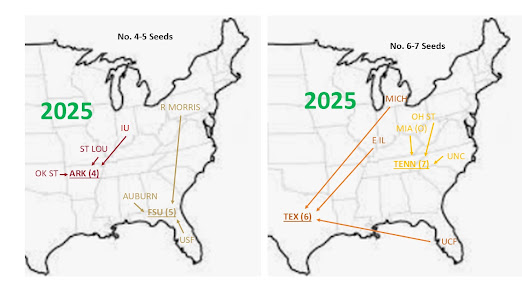The NCAA tournament brackets were released on Sunday and, as an annual traditon here at the College Softball Blog, I have mapped out where teams are coming from to participate in the 16 regional sites. As shown below, each regional contains four teams, with the one nationally seeded team (seed number in parentheses) hosting (you can click on the graphics to enlarge them). Play in the double-elimination regionals begins Friday.
The big question is whether Oklahoma (No. 2 national seed) can make it five national titles in a row at the Women's College World Series. The SEC, into which Oklahoma and Texas moved this year, was absolutely loaded. Fourteen out of the SEC's 15 softball-playing schools made the NCAA field and seven of the eight top national seeds are from the SEC (No. 5 seed Florida State is from the ACC).
The SEC standings -- with Oklahoma (17-7), Texas A&M (16-7), Texas (16-8), and Tennessee (15-9) in a logjam at the top -- show that no team went unscathed. Even the best teams absorbed several losses. The Aggies are the No. 1 national seed, whereas the Longhorns, the preseason No. 1-ranked team, have fallen to a No. 6 tournament seed. As shown in our first graphic, three teams from the East Coast (Marist, St. Francis, and Liberty) will be coming down to College Station to take on A&M. OU will receive teams from all over the country, namely Cal, Nebraska-Omaha, and Boston University. No. 3 Florida (which finished sixth in the SEC at 14-10) has a very compact regional, hosting Florida Atlantic, Georgia Tech, and Mercer. The Gators' selling point is taking two of three from Texas A&M and from Oklahoma.

Regionals hosted by the No. 4 through 7 seeds don't include any teams from the West Coast, so I've put two maps of the eastern half of the U.S. side-by-side. As a Michigan graduate-school alum, I'll be keeping an eye on the Wolverines as they venture down to Texas. Michigan, having gone 0-6 in Big Ten regular-season play against UCLA and Oregon, came back to beat both of these teams en route to winning the conference tournament.
In the regionals involving the No. 8-10 seeded teams, the most interesting story to me is former Oklahoma pitcher Jordy Bahl making her first NCAA-tournament appearance for Nebraska (Bahl joined the Cornhuskers for the 2024 season, but
tore her ACL in that season's opener). Nebraska will be going down to Baton Rouge to participate in a regional that also includes No. 10 seed LSU, Southeast Louisiana, and UConn. Bahl's statistics this season -- 1.57 ERA and .95 WHIP -- were very good, but not as good as her OU numbers.

The other big transfer-pitcher story is that of NiJaree Canady, who moved to Texas Tech this season after two years in the circle for Stanford. Canady's statistics this year -- 0.81 ERA and .69 WHIP -- were more spectacular than Bahl's, as the Red Raiders captured both the regular-season and tournament champions of the depleted Big 12 conference. Texas Tech is the No. 12 seed (lower than I expected) and has some tough competition coming to Lubbock in Mississippi State (which
beat the Red Raiders in an early-season contest) and traditional power Washington. One possible reason for Texas Tech's low seed and tough regional is the Raiders'
2-6 record vs. SEC opponents.
Finally, we have the regionals involving the No. 14-16 national seeds. Oregon's No. 16 seed seems low to me, considering the Ducks' record (47-7 overall including two wins over Florida State and one over Tennessee, and 19-3 in the B1G, with one conference loss each to Washington, UCLA, and Michigan State).
Check back starting Friday for extensive coverage of tournament action!





